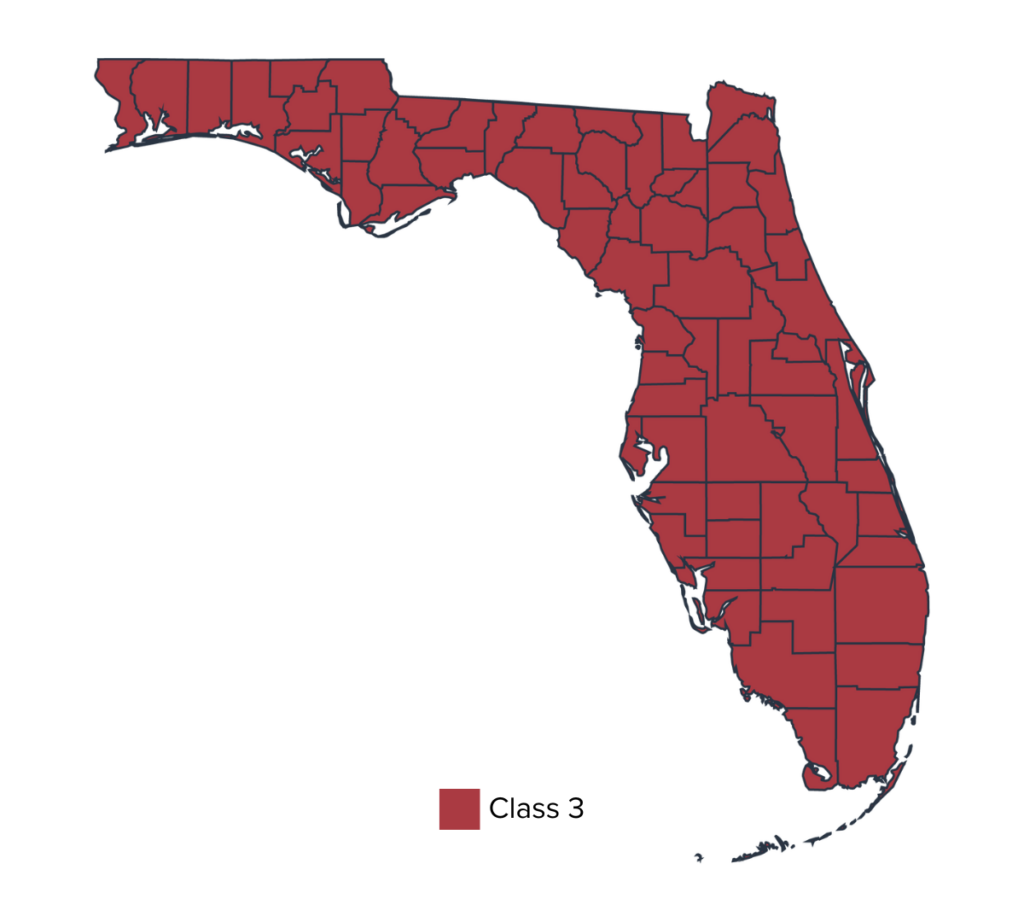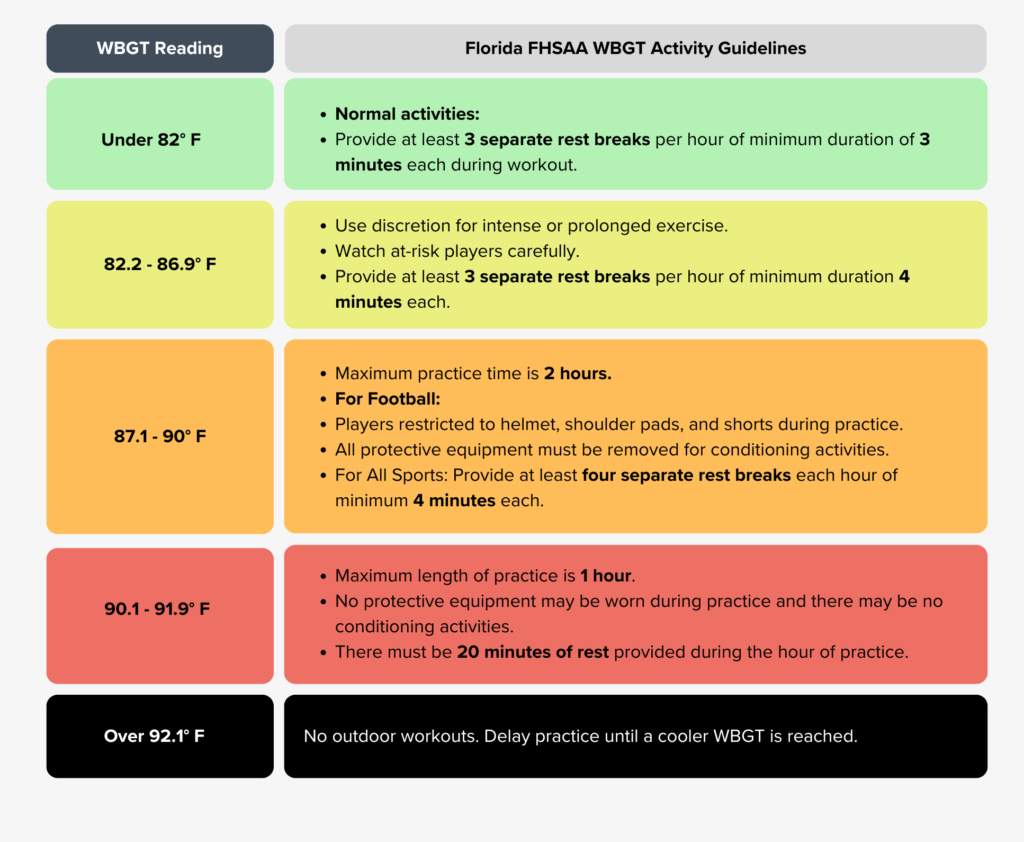How athletic trainers save time and optimize practice times in a high-WBGT environment
The Florida High School Athletic Association (FHSAA) has rolled out wet bulb globe temperature (WBGT) requirements in alignment with the Zachary Martin Act—and it’s changing the game for athletic trainers and coaches across the state.
Florida’s heat is no joke—and the FHSAA’s enforcement of the Zachary Martin Act reinforces that reactive coaching just doesn’t cut it. As a Class 3 state, Florida schools face some of the toughest WBGT demands in the country. Staying compliant—and keeping athletes safe—means being proactive, precise, and prepared.
In this webinar, Perry Weather’s Blake Harvey and Spencer Patton are joined by Mya Tino, Head Athletic Trainer at Booker High School (Sarasota, FL), and Thomas Gorman, Head Athletic Trainer at The Bolles School (Jacksonville, FL), to break down Florida’s heat stress policy, what compliance looks like in the real world, and how athletic trainers can reduce risk—without sacrificing practice quality or wasting time on manual WBGT tracking.
What This FHSAA WBGT Playbook Webinar Covers
In this session, Mya Tino and Thomas Gorman join the Perry Weather team to walk through:
- How to interpret FHSAA’s WBGT zones (Green to Black) and know when to modify practice
- Why Florida’s Class 3 designation matters—and how it affects policy enforcement
- Proactive strategies to prep coaches and players for heat stress before it hits
- Real-world tips for communicating with coaches and handling mid-practice WBGT spikes
- The hidden time costs of handheld sensors—and how to automate zone-based alerts
- New 2025 data trends showing how this year’s heat compares to last summer
Whether you’re new to WBGT or navigating your second season of compliance, this webinar will give you the clarity and tools to stay ahead of the heat.
Key Takeaways from the FHSAA WBGT Webinar

1. Florida Is a Class 3 State—High Acclimatization, High Risk
The entire state of Florida is classified as “Class 3” for heat risk under national athletic heat safety standards, meaning students are considered acclimatized to extreme heat. But this doesn’t mean conditions are safer—it simply changes the thresholds for activity modifications.
Why Class 3 Still Requires Rigor
Florida’s intense humidity, solar radiation, and frequent heat spikes make it one of the most dangerous environments for exertional heat illness. It’s critical that trainers don’t get complacent just because the thresholds allow for longer or more intense activities.
Class 3 = More Flexibility, Not Less Risk
Class 3 states like Florida allow slightly higher WBGT thresholds before modifications kick in, but trainers and coaches must remember: this assumes athletes are already acclimated. For students returning from summer break or new to Florida, that might not be true.
2. FHSAA WBGT Zones Are the Blueprint for Safe Practice

Understanding how to read and respond to WBGT zones is key to compliance—and to preventing life-threatening conditions like heat stroke.
Forecasting WBGT Helps Trainers Stay Ahead
With Perry Weather, trainers can view projected WBGT levels hours in advance, making it easier to plan the day, communicate with coaches, and avoid surprises mid-practice.
Each Zone Has Specific Mandates
- Green (Safe): Normal activity allowed
- Yellow (Caution): Frequent water breaks, shaded rest, close monitoring
- Orange (High Risk): Max 2-hour practices; pre-cooling strategies recommended
- Red (Very High Risk): Pads off, max 1-hour practice
- Black (Extreme Risk): No outdoor activities permitted
Plan for Spikes and Transitions Mid-Practice
Trainers like Mya Tino emphasized that conditions often shift during practice. Coaches must be prepped in advance for changes in activity—such as cutting practice short or removing pads.
3. Handheld WBGT Tools Cost Time—and Often Conflict
Manual WBGT tracking tools—especially Kestrels and other handhelds—can introduce more problems than they solve.
Manual Logging Is a Major Time Sink
Without automation, trainers must stop what they’re doing every 30 minutes to document readings, instead of focusing on injuries, hydration, and student needs.
Calibration and Setup Challenges
Handhelds must acclimate for 20+ minutes before delivering accurate readings. If moved from an air-conditioned office to a hot field, readings can be skewed.
Placement Matters—But Is Often Inconsistent
WBGT readings should be taken 3–6 feet off the ground in shaded, ventilated areas. But in practice, handhelds are often exposed to direct sunlight or placed incorrectly, inflating readings or creating false spikes.
Conflicting Data = Conflicting Decisions
As Thomas Gorman noted, handhelds often produce different readings than automated sensors. With multiple devices in play, it’s unclear which is accurate. Trainers then face unnecessary hesitation or debate—especially under pressure.
4. Automated WBGT Alerts Are a Game-Changer

Perry Weather was purpose-built to reduce the cognitive load on trainers—and give them the tools to act fast, with confidence.
- Real-Time, Site-Specific Data
Perry Weather stations track WBGT, lightning, and other metrics every 5 minutes, right from your campus. The data reflects your field conditions, not a general zip code. - Policy-Based Alerts
You can program your school’s heat policy—down to the WBGT thresholds, rest periods, and gear changes—and Perry Weather will push automatic alerts to coaches, staff, and user groups as soon as a threshold is crossed. - Forecasting for Proactive Planning
Unlike handhelds, Perry Weather forecasts zone changes throughout the day. Trainers can prepare early and notify staff before dangerous levels are reached—not when it’s already too late. - Lightning Safety Built In
Florida leads the nation in lightning density. Perry Weather’s lightning alerts (powered by the National Lightning Detection Network) notify staff immediately—no manual tracking or radar scanning required. - Historical Logs for Compliance
Every reading is automatically logged and exportable for compliance reviews or incident investigations. No paperwork. No spreadsheet nightmares.
5. FHSAA Compliance Isn’t Optional—It’s Legally Required
The Zachary Martin Act sets mandatory standards for heat safety. It’s more than best practice—it’s the law.
- Cooling Zones Must Be Ready and Accessible
Schools are required to have cooling zones on site during all practices and games. Whether it’s a cold-water immersion tub, tarp-and-ice “taco method,” or shaded tent, these setups must be functional and fast. - AEDs and Emergency Action Plans
AEDs must be present and accessible during outdoor activities. Both Mya and Thomas described placing AEDs across campus—including for golf and cross-country athletes—alongside rehearsed emergency response plans. - Hydration Protocols Need Oversight
Schools must implement hydration strategies that include water and electrolytes. Trainers also need to monitor athlete behavior—like over-drinking Gatorade or avoiding water breaks—to ensure safety, not just availability. - Training Support Staff and Student Aides
Delegating setup and monitoring to student aides (when trained) can help expand your safety footprint—especially when athletic trainers are stretched thin.
6. 2025 is Already Hotter Than 2024—And It’s Not Letting Up
New Perry Weather data from on-site Florida stations shows 2025 is trending hotter than the previous year—and those trends matter.
- 48% Increase in Afternoon Red Zone Alerts
In the 2–4 p.m. window—when most practices occur—schools experienced significantly more red zone WBGT levels in 2025 compared to 2024. - Mornings Are Less Safe Than You Think
Even early morning practices saw elevated readings in 2024, with some improvement in 2025. But the variability year-over-year highlights the need for real-time, on-site tracking—not general weather forecasts. - Extremes Are More Common—Middle Ground Is Shrinking
Hours in the orange zone declined by 14% in 2025. That means fewer “moderate” days—and more time spent in either extreme heat (red/black) or unseasonably cool conditions. This unpredictability demands smarter tools and stronger protocols.
FAQs from the FHSAA Heat Stress Management Webinar
What does it mean that Florida is a “Class 3” state, and why does it matter?
Florida is classified as a Class 3 state, meaning athletes are assumed to be more heat-acclimated compared to peers in cooler regions. This classification gives schools slightly more flexibility in WBGT thresholds before restrictions kick in. But as Blake Harvey noted, “Class 3 doesn’t mean it’s less severe—it’s just a different normal.” The heat is still dangerous, and athletic trainers must enforce modifications with the same urgency as anywhere else.
How should athletic trainers manage WBGT zones during practice?
Each WBGT zone requires specific changes: Green = normal activity, Yellow = structured breaks, Orange = max 2 hours, Red = pads off + max 1 hour, Black = no outdoor practice. Trainers like Thomas Gorman stressed the importance of planning for mid-practice spikes and communicating early with coaches. For example, he warns coaches when practice is close to red so they can finish plays before pads come off. Mya Tino added that proactive communication and forecasting in Perry Weather help prevent last-minute chaos.
What cooling zones, hydration, and emergency equipment are required by the Zachary Martin Act?
Florida law mandates that every school have:
-
A cooling zone (ice tubs, tarp + ice “taco method,” or equivalent)
-
AEDs accessible at all times
-
Hydration protocols, including water and electrolytes
-
A clear Emergency Action Plan for exertional heat illness
Both Thomas and Mya stressed the need for preparation—pre-filling tubs halfway, having coolers of ice nearby, and training student aides to help. These steps ensure compliance and protect athletes when heat stress incidents occur.
Should athletes ever train in black WBGT conditions to prepare for games?
Thomas and Mya emphasized that safety comes first—state law prohibits outdoor practice in black conditions for a reason. They noted that games have additional safeguards like EMS, team doctors, and larger medical staff present, which practices don’t. Long-term, this may be an area for FHSAA to revisit, but for now, compliance with the law is non-negotiable.
Why does Perry Weather place sensors on rooftops or press boxes, not at field level?
Perry Weather stations are mounted higher up to ensure continuous calibration, airflow, and shielded radiation exposure. Independent studies confirm that readings taken at 3–6 feet versus rooftop-mounted stations are nearly identical once adjusted for wind and temperature. Blake explained that keeping sensors stationary ensures accurate, real-time data without the fluctuations common to portable units.
How should trainers handle mid-practice WBGT spikes—especially moving from orange to red, or red to black?
Both Thomas and Mya agreed: communication is key. If WBGT spikes into red, athletic trainers notify coaches immediately and remove pads, often using water breaks to buy time while monitoring conditions. If WBGT spikes into black, Mya calls practice—safety comes before finishing drills. Trainers emphasized flexibility: if conditions dip back into orange for a sustained period, coaches may resume lighter activity, but only if safety protocols and hydration are strictly followed.
Thanks for joining us. We hope the webinar gave you practical takeaways for managing heat stress and keeping athletes safe. Perry Weather removes the guesswork from weather safety decisions—try it yourself with a free two-week trial.












